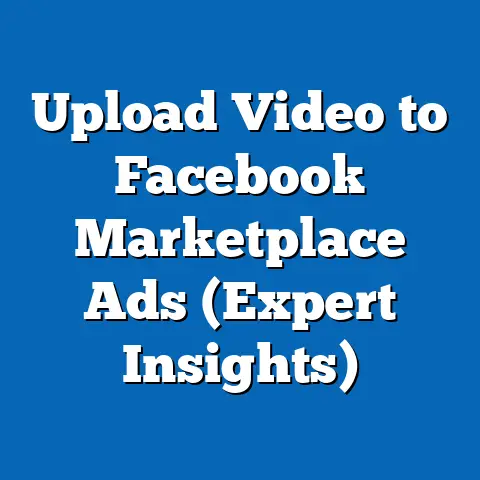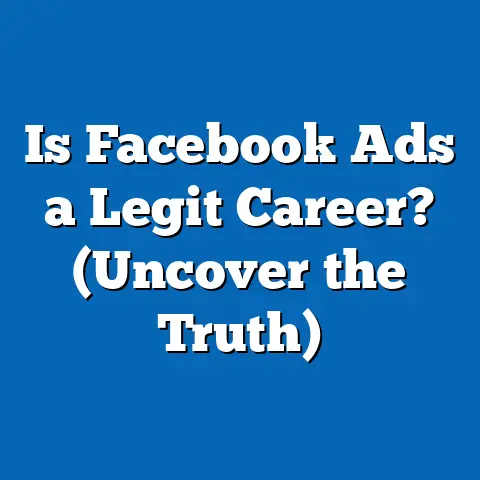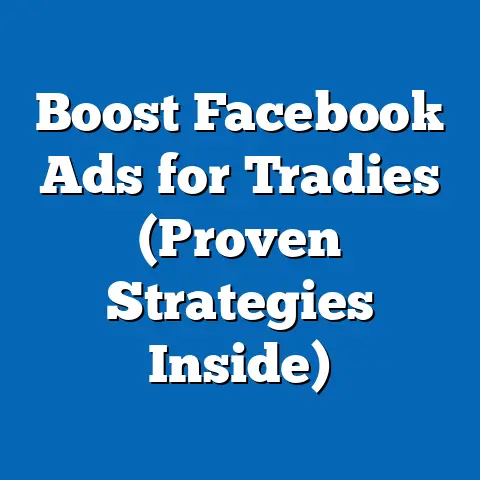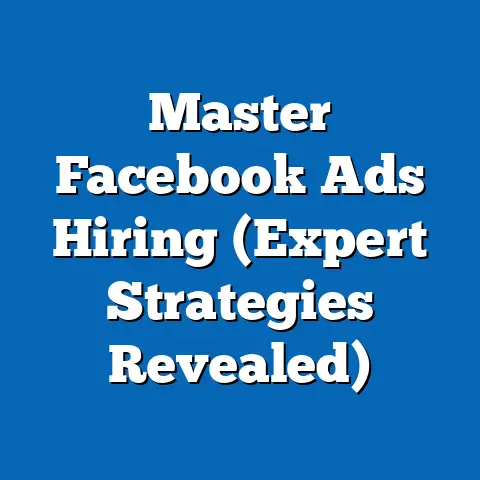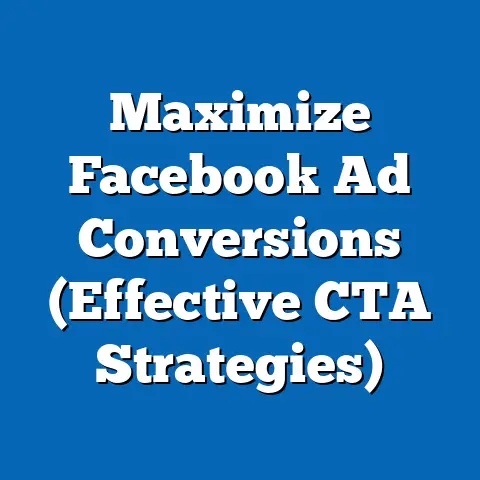Boost Charity Facebook Ads for Maximum Impact (Expert Tips)
Picture this: Bob, bless his heart, thinks he’s cracked the code to fundraising. He’s convinced that a blurry photo of his cat, Mittens, looking vaguely sad, accompanied by the caption “Help Mittens help others!” will rake in millions for his local animal shelter. He boosts the post for $5 and waits for the donations to flood in. Spoiler alert: Mittens remains a local celebrity, but the shelter’s budget doesn’t see much of a boost.
That, my friends, is why understanding how to effectively use Facebook ads for your charity is crucial. It’s not enough to have a good cause and a cute cat. You need a strategy, a sprinkle of creativity, and a dash of technical know-how.
Facebook advertising, when done right, can be a game-changer for charities. It offers unparalleled reach, allowing you to connect with potential donors who are genuinely passionate about your cause. And that’s what this article is all about – providing you with expert tips to maximize the impact of your charity’s Facebook ads. We’re going to dive deep into creating compelling ad copy, targeting the right audience, managing your budget like a pro, and much more. Get ready to ditch the sad cat photos and embrace the power of strategic Facebook advertising!
Understanding the Facebook Advertising Landscape
Okay, let’s get down to brass tacks. Facebook advertising isn’t just about slapping up any old post and hoping for the best. It’s a complex ecosystem with its own rules, language, and, yes, even its own sense of humor. For charities, understanding these nuances is vital.
First, let’s talk about the basics. When I say “Facebook advertising,” I’m referring to the paid promotion of your charity’s message to a specific audience on Facebook and Instagram (which, let’s face it, is basically the same thing these days). This allows you to reach people far beyond your existing followers, expanding your potential donor base exponentially.
What makes Facebook advertising particularly well-suited for charities? Here are a few key reasons:
- Targeted Reach: Facebook’s detailed targeting options allow you to pinpoint individuals who are most likely to support your cause. You can target based on demographics, interests, behaviors, and even life events.
- Diverse Ad Formats: From eye-catching image ads to immersive video ads and engaging carousel ads, Facebook offers a variety of formats to tell your charity’s story.
- Measurable Results: Facebook provides robust analytics that allow you to track the performance of your ads, measure your return on investment (ROI), and optimize your campaigns for better results.
- Cost-Effective: Compared to traditional advertising channels, Facebook advertising can be incredibly cost-effective, especially for small and medium-sized charities.
Now, let’s talk about ad formats. Each one has its own strengths and weaknesses, and the right choice depends on your specific goals and target audience:
- Image Ads: These are the workhorses of Facebook advertising. They’re simple, versatile, and can be incredibly effective when paired with compelling visuals and concise copy. Charities can use image ads to showcase their work, highlight the impact of donations, or promote upcoming events.
- Video Ads: Video is king in the digital world, and Facebook is no exception. Video ads are incredibly engaging and can be used to tell powerful stories, share testimonials, or provide behind-the-scenes glimpses into your charity’s work.
- Carousel Ads: These ads allow you to showcase multiple images or videos in a single ad unit. Charities can use carousel ads to highlight different aspects of their work, showcase multiple beneficiaries, or promote a series of related events.
- Instant Experience Ads: These are full-screen, mobile-optimized ads that provide an immersive experience for users. Charities can use Instant Experience ads to tell a more in-depth story, showcase their impact, or encourage users to take action.
To illustrate the power of Facebook’s reach, let’s look at some statistics:
- User Demographics: Facebook boasts over 2.9 billion monthly active users worldwide, spanning a wide range of demographics. This means that no matter who your target audience is, you’re likely to find them on Facebook.
- Engagement Rates: Facebook users are highly engaged, spending an average of 30 minutes per day on the platform. This provides ample opportunity to capture their attention and inspire them to support your cause.
- Donation Potential: Studies have shown that Facebook users are more likely to donate to charities that they see advertised on the platform. This highlights the potential for Facebook advertising to drive significant fundraising results.
I like to think of Facebook ads as fishing. You wouldn’t just throw a bare hook into the water and expect to catch a prize-winning marlin, right? You need the right bait (your ad creative), the right line (your targeting strategy), and the right reel (your budget) to land the big one (a generous donor).
Key Takeaway: Understanding the basics of Facebook advertising, including its benefits, ad formats, and potential reach, is essential for charities looking to make a big impact.
Next Step: Take some time to explore the different ad formats available on Facebook and brainstorm how you can use each one to tell your charity’s story.
Now, let’s talk about the real magic: crafting ad copy and creative that grabs attention, tugs at heartstrings, and inspires action.Let’s start with a funny analogy. Imagine you’re at a party, and someone approaches you with a monotone voice, droning on and on about their charity without ever making a personal connection. Would you be inspired to donate? Probably not. Your ad copy is your first impression, so make it count!
Here are some common mistakes I see charities make with their ad copy:
- Overly Verbose Ads: Nobody wants to read a novel in their Facebook feed. Keep your copy concise, clear, and to the point.
- Vague Calls to Action: Don’t leave people guessing what you want them to do. Use strong, clear calls to action like “Donate Now,” “Volunteer Today,” or “Learn More.”
- Generic Language: Avoid using generic language that could apply to any charity. Be specific about what makes your organization unique and why people should support you.
Now, let’s dive into the art of storytelling. Storytelling is incredibly powerful, especially for charities. When you share a compelling narrative about the people you help, the challenges you face, and the impact you make, you create an emotional connection with potential donors.
Here are some tips for crafting compelling narratives in your ad copy:
- Focus on the Human Element: Share stories about real people who have been impacted by your charity’s work. Use names, photos, and quotes to bring these stories to life.
- Highlight the Problem and the Solution: Clearly articulate the problem your charity is addressing and how you are working to solve it.
- Show the Impact of Donations: Explain how donations directly translate into positive change. For example, “Your $50 donation can provide a week of meals for a family in need.”
- Use Emotional Language: Don’t be afraid to tug at heartstrings. Use emotional language that evokes empathy, compassion, and hope.
But it’s not just about the words. High-quality visuals are just as important as compelling copy. Think of your visuals as the eye candy that draws people in. They should be professional, visually appealing, and aligned with your charity’s brand.
Here are some tips for creating eye-catching visuals for your Facebook ads:
- Use High-Resolution Images and Videos: Avoid blurry or pixelated visuals. Use high-resolution images and videos that are clear, crisp, and visually appealing.
- Showcase Your Work: Use visuals that showcase your charity’s work in action. This could include photos of volunteers helping people, videos of beneficiaries sharing their stories, or images of the positive impact you are making.
- Use Faces: Faces are incredibly powerful. Use photos and videos that feature the faces of the people you help, your volunteers, or your staff.
- Keep it Simple: Avoid cluttered or busy visuals. Keep your visuals simple, clean, and easy to understand.
Humor can be a powerful tool, but it’s important to use it judiciously. If your charity is addressing a serious issue, humor may not be appropriate. However, if your cause is lighter in nature, a touch of humor can help your ads stand out and connect with potential donors.
Here are some tips for incorporating humor into your charity ads:
- Use Relatable Humor: Use humor that is relatable to your target audience. This could include jokes about common challenges, funny observations about everyday life, or lighthearted memes.
- Don’t Be Offensive: Avoid using humor that is offensive, insensitive, or inappropriate.
- Keep it Light: Keep your humor light and positive. Avoid using sarcasm, cynicism, or negativity.
Emotional appeal, on the other hand, is almost always a good strategy for charity ads. When you tap into people’s emotions, you create a connection that goes beyond logic and reason.
Here are some tips for incorporating emotional appeal into your charity ads:
- Focus on Empathy: Evoke empathy by sharing stories of people who are struggling or in need.
- Highlight Hope: Show how your charity is working to create a better future for those in need.
- Inspire Action: Encourage people to take action and make a difference.
- Use Powerful Imagery: Use visuals that evoke strong emotions, such as photos of children smiling, families reunited, or communities thriving.
Key Takeaway: Compelling ad copy and creative are essential for capturing attention, building emotional connections, and inspiring action.
Next Step: Review your existing Facebook ads and identify areas where you can improve your copy, visuals, and emotional appeal.
Targeting the Right Audience
Let’s say you’ve crafted the most heartwarming, visually stunning ad the world has ever seen. But if you’re showing it to people who have zero interest in your cause, it’s like serenading a brick wall. That’s where audience targeting comes in.
Facebook’s targeting options are like a superpower for charities. They allow you to laser-focus your ads on the people who are most likely to support your mission. But with so many options available, it can be overwhelming to know where to start.
First, let’s talk about the different types of targeting options available on Facebook:
- Demographics: This includes basic information like age, gender, location, education, and income.
- Interests: This includes people’s interests, hobbies, and passions, based on their activity on Facebook.
- Behaviors: This includes people’s behaviors, such as their purchase history, travel habits, and online activity.
- Connections: This includes people who are connected to your Facebook page, your events, or your website.
- Custom Audiences: This allows you to upload your own data, such as email lists or phone numbers, to target specific individuals.
- Lookalike Audiences: This allows you to create audiences that are similar to your existing customers or supporters.
Now, let’s talk about audience segmentation. This is the process of dividing your target audience into smaller, more specific groups based on their characteristics, interests, and behaviors. This allows you to tailor your ads to each segment, increasing their relevance and effectiveness.
Here are some tips for segmenting your audience for charity ads:
- Identify Your Ideal Donor: Who is the most likely person to support your charity? What are their demographics, interests, and behaviors?
- Segment Based on Giving History: If you have data on your existing donors, segment them based on their giving history. This allows you to target them with ads that are tailored to their level of support.
- Segment Based on Interests: Segment your audience based on their interests related to your cause. For example, if you’re a wildlife conservation charity, you could target people who are interested in animals, nature, or environmental conservation.
- Segment Based on Location: Segment your audience based on their location. This allows you to target people who are living in areas where your charity operates or where your programs have a significant impact.
Lookalike audiences are one of the most powerful targeting tools available on Facebook. They allow you to expand your reach by targeting people who are similar to your existing supporters.
Here’s how to create lookalike audiences for your charity ads:
- Start with a Seed Audience: Choose a seed audience that is representative of your ideal donor. This could be your existing email list, your Facebook page fans, or your website visitors.
- Choose Your Lookalike Percentage: Facebook allows you to choose the percentage of the population that you want to target with your lookalike audience. A lower percentage will result in a more targeted audience, while a higher percentage will result in a broader audience.
- Test and Refine: Once you’ve created your lookalike audience, test it against other targeting options to see which performs best. Refine your lookalike audience over time based on your results.
Targeting your ads is like dating. You wouldn’t want to propose to someone on the first date, right? You need to get to know them, understand their interests, and build a connection before you pop the question. Similarly, you wouldn’t want to target your ads to people who have no interest in your cause. You need to find the people who are most likely to support your mission and build a relationship with them.
Key Takeaway: Targeting the right audience is crucial for maximizing the impact of your charity’s Facebook ads.
Next Step: Take some time to explore Facebook’s targeting options and brainstorm how you can use them to reach your ideal donor.
Budgeting for Success
So, you’ve got killer ad copy, stunning visuals, and you’re targeting the perfect audience. But without a solid budget, your campaign is like a race car with an empty gas tank. Let’s talk about how to set and manage your ad budget for maximum impact.
Setting a budget for your Facebook ads can feel like a guessing game, especially for charities with limited resources. But it doesn’t have to be. There are several strategies you can use to determine the right budget for your campaign.
First, let’s talk about the different types of budgets available on Facebook:
- Daily Budget: This is the average amount you’re willing to spend on your ads each day.
- Lifetime Budget: This is the total amount you’re willing to spend on your ads over the entire duration of your campaign.
So, which budget type is right for your charity? Here are some things to consider:
- Campaign Duration: If you’re running a short-term campaign, such as a fundraising drive or an event promotion, a lifetime budget may be the best option.
- Campaign Goals: If you’re running a long-term campaign, such as building brand awareness or growing your email list, a daily budget may be more appropriate.
- Budget Flexibility: If you need to be able to adjust your budget on the fly, a daily budget may be the best option.
Once you’ve chosen a budget type, you need to determine how much to spend. Here are some tips for setting your ad budget:
- Start Small: If you’re new to Facebook advertising, start with a small budget and gradually increase it as you see results.
- Consider Your Goals: How much are you trying to raise? How many new donors are you trying to acquire? Use these goals to guide your budget decisions.
- Research Industry Benchmarks: Research how much other charities are spending on Facebook advertising. This can give you a sense of what’s reasonable and effective.
- Test and Iterate: Don’t be afraid to experiment with different budget levels to see what works best for your campaign.
Optimizing your ad spend is crucial for maximizing your ROI. Here are some tips for getting the most bang for your buck:
- A/B Testing: Test different ad copy, visuals, and targeting options to see what performs best.
- Monitor Ad Performance: Keep a close eye on your ad performance metrics, such as click-through rate (CTR), cost per click (CPC), and conversion rate.
- Adjust Bids: Adjust your bids based on your ad performance. If your ads are performing well, increase your bids to reach more people. If your ads are performing poorly, decrease your bids to save money.
- Use Automated Bidding: Facebook offers automated bidding options that can help you optimize your ad spend. These options use machine learning to automatically adjust your bids based on your campaign goals.
Budgeting for Facebook ads is like planning a wedding on a shoestring budget. You need to prioritize what’s most important, get creative with your resources, and make every dollar count. But with careful planning and optimization, you can make your budget go a long way and achieve your fundraising goals.
Key Takeaway: Setting and managing your ad budget effectively is crucial for maximizing your ROI.
Next Step: Review your existing ad campaigns and identify areas where you can optimize your ad spend.
Engaging with Your Audience
You’ve got the perfect ad, the perfect target audience, and the perfect budget. But your job isn’t done yet. Now, you need to engage with your audience and build a community around your cause.
Engagement is the secret sauce that takes your Facebook ads from good to great. It’s not enough to simply show your ads to people. You need to get them involved, spark conversations, and build relationships.
Here are some reasons why engagement is so important:
- Increased Reach: When people engage with your ads, their friends are more likely to see them. This can significantly increase your reach.
- Stronger Brand Awareness: Engagement helps to build brand awareness and recognition. When people see your ads and interact with your brand, they’re more likely to remember you in the future.
- Improved Conversion Rates: Engagement can lead to higher conversion rates. When people feel connected to your brand, they’re more likely to donate, volunteer, or take other actions.
- Valuable Feedback: Engagement provides valuable feedback about your ads and your overall marketing strategy. You can use this feedback to improve your campaigns and better serve your audience.
Responding to comments, messages, and shares is a crucial part of engagement. It shows that you’re listening to your audience and that you care about their opinions.
Here are some tips for responding to comments, messages, and shares:
- Respond Promptly: Respond to comments and messages as quickly as possible. This shows that you’re attentive and responsive.
- Be Authentic: Be yourself and let your personality shine through. People are more likely to engage with brands that feel genuine.
- Be Helpful: Answer questions, provide information, and offer support.
- Be Positive: Maintain a positive and upbeat tone, even when dealing with negative comments or feedback.
Creating a community around your cause on Facebook can be a powerful way to build relationships, foster engagement, and drive donations.
Here are some strategies for creating a community on Facebook:
- Create a Facebook Group: Create a Facebook group for your supporters to connect with each other, share their stories, and learn more about your cause.
- Host Live Events: Host live events on Facebook, such as Q&A sessions, behind-the-scenes tours, or virtual fundraising events.
- Run Contests and Giveaways: Run contests and giveaways to encourage engagement and reward your supporters.
- Share User-Generated Content: Share content created by your supporters, such as photos, videos, or testimonials.
To illustrate the power of audience engagement, let’s look at some successful examples of charities that have effectively engaged their audience through Facebook:
- The ALS Association: The ALS Association has used Facebook to raise awareness about ALS, share stories of people living with the disease, and encourage donations. They have also created a Facebook group for people with ALS and their families to connect with each other.
- The American Red Cross: The American Red Cross has used Facebook to provide disaster relief information, recruit volunteers, and encourage blood donations. They have also used Facebook Live to broadcast press conferences and provide updates during disasters.
- charity: water: charity: water has used Facebook to share stories of people who have been impacted by their work, raise awareness about the global water crisis, and encourage donations. They have also used Facebook to create a community of supporters who are passionate about solving the water crisis.
Engaging with your audience is like being a good friend. You listen to their concerns, offer support, and build a relationship based on trust and mutual respect. When you treat your audience like friends, they’re more likely to support your cause and become lifelong donors.
Key Takeaway: Engaging with your audience is essential for building relationships, fostering community, and driving donations.
Next Step: Review your existing Facebook presence and identify areas where you can improve your engagement strategies.
Measuring Success and Iterating
You’ve launched your campaign, you’re engaging with your audience, and the donations are trickling in. But how do you know if your Facebook ads are truly making a difference? That’s where measuring success and iterating comes in.
Measuring the success of your Facebook ads is crucial for understanding what’s working, what’s not, and how you can improve your campaigns over time. It’s like fine-tuning a recipe. Even the best chefs tweak their ingredients based on feedback to create the perfect dish.
Here are some key performance indicators (KPIs) that charities should track to measure the success of their Facebook ads:
- Reach: The number of people who saw your ads.
- Impressions: The number of times your ads were displayed.
- Click-Through Rate (CTR): The percentage of people who clicked on your ads.
- Cost Per Click (CPC): The average cost you paid for each click on your ads.
- Conversion Rate: The percentage of people who took a desired action after clicking on your ads, such as donating, volunteering, or signing up for your email list.
- Cost Per Conversion: The average cost you paid for each conversion.
- Return on Ad Spend (ROAS): The amount of revenue you generated for every dollar you spent on advertising.
Analytics are your best friend when it comes to measuring the success of your Facebook ads. Facebook provides a wealth of data that you can use to track your KPIs, understand your audience, and optimize your campaigns.
Here are some tips for using analytics to improve your Facebook ads:
- Track Your KPIs: Keep a close eye on your KPIs to see how your ads are performing.
- Analyze Your Audience Data: Use Facebook’s audience insights to learn more about your target audience, such as their demographics, interests, and behaviors.
- Identify Trends: Look for trends in your data to see what’s working and what’s not.
- Experiment and Iterate: Don’t be afraid to experiment with different ad copy, visuals, and targeting options to see what performs best.
The Facebook Pixel is a powerful tool that allows you to track conversions on your website and retarget people who have visited your website.
Here are some tips for setting up Facebook Pixel for your charity:
- Install the Pixel on Your Website: Add the Facebook Pixel code to your website to start tracking conversions.
- Create Conversion Events: Create conversion events to track specific actions that you want to measure, such as donations, volunteer sign-ups, or email subscriptions.
- Retarget Website Visitors: Retarget people who have visited your website with ads that are tailored to their interests.
Measuring success and iterating is like being a scientist. You conduct experiments, collect data, analyze the results, and refine your hypotheses. By continually testing and iterating, you can improve your Facebook ads over time and achieve your fundraising goals.
Key Takeaway: Measuring success and iterating is essential for optimizing your Facebook ads and achieving your fundraising goals.
Next Step: Review your existing Facebook ads and identify areas where you can improve your tracking, analysis, and optimization efforts.
Conclusion
We’ve covered a lot of ground in this guide, from understanding the Facebook advertising landscape to crafting compelling ad copy, targeting the right audience, managing your budget, engaging with your community, and measuring your success.
Remember Bob, our well-meaning friend with the sad cat photo? Imagine that after reading this guide, Bob decided to take a different approach. He learned about the power of storytelling and created a video showcasing the incredible work his animal shelter was doing. He used Facebook’s targeting options to reach people who were passionate about animal welfare. He set a reasonable budget and monitored his results closely. And guess what? Bob’s campaign was a huge success! He raised thousands of dollars for his shelter, and Mittens became a true fundraising superstar.
The key takeaways from this guide are:
- Strategic Planning: Develop a clear strategy for your Facebook ads, including your goals, target audience, budget, and messaging.
- Creativity: Use compelling ad copy, visuals, and storytelling to capture attention and inspire action.
- Audience Engagement: Engage with your audience, build relationships, and foster a community around your cause.
- Data-Driven Optimization: Track your results, analyze your data, and continually optimize your campaigns for better performance.
Now, it’s your turn to take action. Implement the tips and strategies shared in this guide, and watch your charity’s Facebook ads transform from mediocre to magnificent. And who knows, maybe you’ll even inspire Bob to give Mittens a well-deserved retirement!
Call to Action
I encourage you to share your own experiences with charity ads in the comments below. What strategies have worked well for you? What challenges have you faced? And if you have any questions or need more tips and guidance, don’t hesitate to reach out. Together, we can make a positive impact on the world, one Facebook ad at a time.


